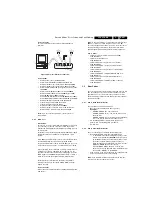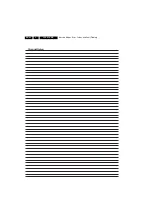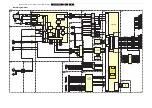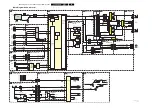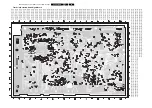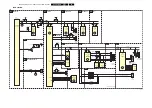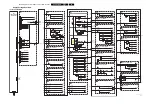
Service Modes, Error Codes, and Fault Finding
EN 16
LC4.41A AA
5.
Then:
1.
Press the SMART PICTURE button on the remote control
transmitter repeatedly (if necessary) to choose
PERSONAL picture mode.
2.
Press the MENU button on the remote control transmitter.
This brings up the normal user menu.
3.
In the normal user menu, use the MENU UP/DOWN keys
to select the PICTURE sub menu.
4.
Press the MENU LEFT/RIGHT keys to enter the PICTURE
sub menu.
5.
Use the MENU UP/DOWN keys (if necessary) to select
BRIGHTNESS.
6.
Press the MENU LEFT/RIGHT keys to increase or
decrease the value of the selected parameter.
7.
Use the MENU UP/DOWN keys to select STORE.
8.
Press the MENU RIGHT key to store the new value.
9.
Press the MENU key to exit the PERSONAL picture mode.
White Line around Picture Elements and Text
If:
The picture improves after you have pressed the SMART
PICTURE button on the remote control transmitter,
Then:
1.
Press the SMART PICTURE button on the remote control
transmitter repeatedly (if necessary) to choose
PERSONAL picture mode.
2.
Press the MENU button on the remote control transmitter.
This brings up the normal user menu.
3.
In the normal user menu, use the MENU UP/DOWN keys
to select the PICTURE sub menu.
4.
Press the MENU LEFT/RIGHT keys to enter the PICTURE
sub menu.
5.
Use the MENU UP/DOWN keys (if necessary) to select
SHARPNESS.
6.
Press the MENU LEFT/RIGHT keys to increase or
decrease the value of the selected parameter.
7.
Use the MENU UP/DOWN keys to select STORE.
8.
Press the MENU RIGHT key to store the new value.
9.
Press the MENU key to exit the PERSONAL picture mode.
Snowy Picture
Check CSM line 6. If this line reads “Not Tuned”, check the
following:
•
Antenna not connected. Connect the antenna.
•
No antenna signal or bad antenna signal. Connect a proper
antenna signal.
•
The tuner is faulty (in this case line 2, the Error Buffer line,
will contain error number 10). Check the tuner and replace/
repair the tuner if necessary.
Black and White Picture
If:
•
The picture improves after you have pressed the SMART
PICTURE button on the remote control transmitter,
Then:
1.
Press the SMART PICTURE button on the remote control
transmitter repeatedly (if necessary) to choose
PERSONAL picture mode.
2.
Press the MENU button on the remote control transmitter.
This brings up the normal user menu.
3.
In the normal user menu, use the MENU UP/DOWN keys
to select the PICTURE sub menu.
4.
Press the MENU LEFT/RIGHT keys to enter the PICTURE
sub menu.
5.
Use the MENU UP/DOWN keys (if necessary) to select
COLOUR.
6.
Press the MENU LEFT/RIGHT keys to increase or
decrease the value of the selected parameter.
7.
Use the MENU UP/DOWN keys to select STORE.
8.
Press the MENU RIGHT key to store the new value.
9.
Press the MENU key to exit the PERSONAL picture mode.
5.4
Service Tools
5.4.1
ComPair
Introduction
ComPair (Computer Aided Repair) is a service tool for Philips
Consumer Electronics products. ComPair is a further
development on the European DST (service remote control),
which allows faster and more accurate diagnostics. ComPair
has three big advantages:
1.
ComPair helps you to quickly get an understanding on how
to repair the chassis in a short time by guiding you
systematically through the repair procedures.
2.
ComPair allows very detailed diagnostics (on I
2
C level) and
is therefore capable of accurately indicating problem areas.
You do not have to know anything about I
2
C commands
yourself because ComPair takes care of this.
3.
ComPair speeds up the repair time since it can
automatically communicate with the chassis (when the
microprocessor is working) and all repair information is
directly available. When ComPair is installed together with
the Force/SearchMan electronic manual of the defective
chassis, schematics and PWBs are only a mouse click
away.
Specifications
ComPair consists of a Windows based fault finding program
and an interface box between PC and the (defective) product.
The ComPair interface box is connected to the PC via a serial
(or RS-232) cable.
For this chassis, the ComPair interface box and the TV
communicate via a bi-directional service cable via the service
connector(s).
The ComPair fault finding program is able to determine the
problem of the defective television. ComPair can gather
diagnostic information in two ways:
•
Automatically (by communicating with the television):
ComPair can automatically read out the contents of the
entire error buffer. Diagnosis is done on I
2
C/UART level.
ComPair can access the I
2
C/UART bus of the television.
ComPair can send and receive I
2
C/UART commands to
the micro controller of the television. In this way, it is
possible for ComPair to communicate (read and write) to
devices on the I
2
C/UART buses of the TV-set.
•
Manually (by asking questions to you): Automatic
diagnosis is only possible if the micro controller of the
television is working correctly and only to a certain extent.
When this is not the case, ComPair will guide you through
the fault finding tree by asking you questions
(e.g. Does the
screen give a picture? Click on the correct answer: YES /
NO)
and showing you examples
(e.g. Measure test-point I7
and click on the correct oscillogram you see on the
oscilloscope)
. You can answer by clicking on a link
(e.g.
text or a waveform picture)
that will bring you to the next
step in the fault finding process.
By a combination of automatic diagnostics and an interactive
question / answer procedure, ComPair will enable you to find
most problems in a fast and effective way.
















